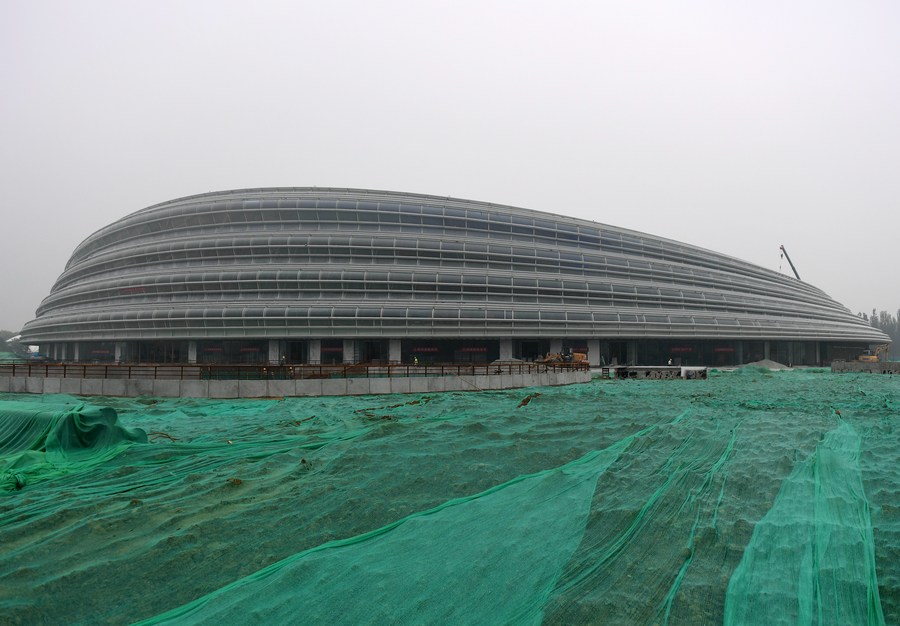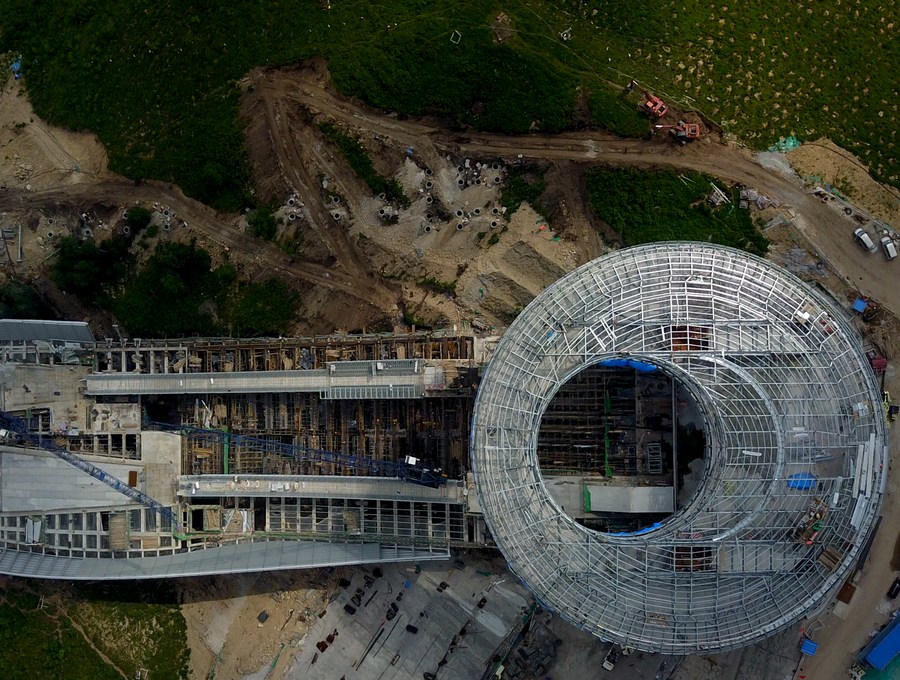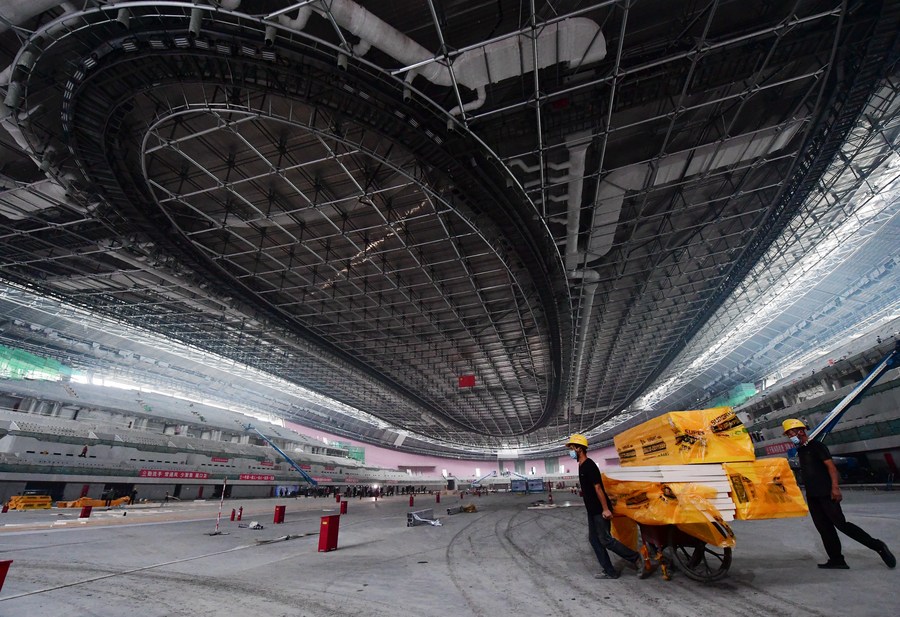
This photo taken on Nov. 1, 2019 shows the general view of Big Air Shougang, one of the competition venues for Beijing 2022 Winter Olympic Games. (Xinhua/Zhang Chenlin)
Five years after winning the bid to host the 2022 Olympic Winter Games, Beijing and Zhangjiakou are en route to staging a 'green, inclusive, open and clean' Games as promised.
By sportswriters Wang Meng, Ji Ye and Lu Xingji
BEIJING, July 31 (Xinhua) -- "Beijing!" The city's name was called at an IOC Session in Kuala Lumpur on July 31, 2015 to be announced as the host city of the 2022 Olympic Winter Games.
Five years on, Beijing, the first city to host both summer and winter Games, and the co-host city of Zhangjiakou, are en route to staging a 'green, inclusive, open and clean' Games as promised.
Despite the impact of the COVID-19 pandemic, all the Games' competition venues and related infrastructure will be completed by the end of this year, with sustainability given priority from the very beginning, in line with reforms introduced through the Olympic Agenda 2020.
BUILDING ON THE PAST
Once an industrial complex, Shougang Park will stage the Big Air event, where top snowboarders will compete against a backdrop of coolant towers. Its iron ore storage towers were converted to house the headquarters of the Beijing 2022 Organizing Committee - where decisions were made to maximize the use of existing venues and facilities.
And thanks to a successful 2008 Games, legacies were abundant.
Of the 2022 Games' 44 venues and facilities, 25 are renovated from existing ones, six are temporary, and six were part of the city's plan before the bid. Only seven of them, or 16 percent of the total, are newly built for the Games.
The "water cube," the swimming and diving venue from 2008, has been converted into the "ice cube" featuring a transferable rink for curling events.
"Thanks to the Winter Games, the facility was upgraded and energy consumption lowered. Its new form will bring new income, and the cost of water-ice conversion is much lower than building a new venue," said Yang Qiyong, general manager of the venue.

This July 28, 2020 photo shows the iconic "Water Cube" swimming venue from the 2008 Olympics, which now has become the "Ice Cube". (Xinhua/Zhang Chenlin)
The Bird's Nest stadium, another symbolic legacy from 2008, will stage Beijing 2022's opening and closing ceremonies, just as it did 12 years ago. The National Indoor Stadium, which hosted 2008's gymnastics, trampoline, and handball events, will play host to the men's ice hockey competitions, while the women's event will be staged at the Wukesong Sports Center, a basketball venue from 2008, which is capable of switching between two kinds of playing surfaces within six hours.
According to Ding Jianming, deputy director of the Beijing Major Projects Construction Headquarters Office, venues in the Beijing competition zone will all be transferable between summer and winter sports.
In the Zhangjiakou competition zone, the Genting Snow Park, which will host freestyle skiing and snowboard events at Beijing 2022, was also renovated from the existing ski resort. Surplus stones after the evacuation and filling process were used in other parts, including building temporary roads and slope protection.
EYEING THE FUTURE
Ensuring Olympic venues are adequately used after the event is a challenging task facing every organizer, and Beijing is no exception.
The National Speed Skating Oval, the only newly-built ice sports venue for the 2022 Games, has seen its main structure completed. Nicknamed the "Ice Ribbon," the site boasts the most extensive full ice design in Asia, with an ice surface area of 12,000 square meters.
"The purpose is to give full consideration to post-competition utilization and provide hardware support for mass fitness and to meet various needs," said Ma Jin, design director of the ice making project.
He went on to explain that the ice in the oval has adopted a submodule control unit, which can divide the ice surface into several areas and make ice according to varying standards.
During ordinary times, it can hold more than 2,000 people and be utilized for ice hockey, speed skating, figure skating, curling, and other ice sports all at the same time.

The National Speed Skating Oval, also known as the "Ice Ribbon", is the only newly-built ice sports venue for the 2022 Beijing Winter Olympics. (Xinhua/Zhang Chenlin)
Like the "Ice Ribbon," all venues in Beijing will not only display international and domestic sports events but will open to the public after the 2022 Games.
Alpine skiing, bobsleigh, skeleton, and luge are not familiar sports for many Chinese people, meaning organizers needed to pay extra attention to post-game utilization when designing the National Alpine Ski Center and National Sliding Center in the Yanqing competition zone. Ski tracks will be developed in the surrounding area for primary and intermediate skiers while competition tracks will stay in place for high-level competitions.
Just like the 2008 Games, Beijing 2022 strives to leave legacies that will help fuel the passion for winter sports in the country and encourage people to adopt a healthy lifestyle.
Sustainability is also reflected in the eco-friendly measures adopted along the process.
"To reduce the adverse impact on the ecological environment, Beijing 2022 will prioritize ecological protection in the whole process of venue planning, construction, operation and post-match utilization," said Liu Xinping, director of the Sustainable Development Division of the Beijing 2022 General Planning Department.

In addition to the Olympic Village, all trees in the entire Yanqing competition zone for Beijing 2022 were registered and had their profiles marked with a QR code. (Xinhua/Zhang Chenlin)
At the bottom of the Xiaohaituo mountain in the Yanqing competition zone, a protected 20 hectares of trees constitutes part of the Winter Olympic Forest Park, which is currently under construction.
What makes them different is that each of them has a profile - scan the QR code attached to them and you can learn about their "life."
"We tried our best to leave the trees where they were when we designed the competition courses. If that was not possible, we moved some of them to nearby sites, or transplanted them down to the Winter Olympic Forest Park," Liu said.
In fact, a detailed investigation of local wildlife was conducted well before construction started in order to protect biodiversity. The contractor, Beijing Enterprises J.O Construction, formed an independent department to address ecological protection.
"Although we tried to avoid trees in designing construction sites when we tried to set up a tower crane, we found it may cause potential harm to the nearby trees if the machine was to be set at the optimal location. So we changed the plan, replaced it with a larger model with longer jibs, although it took us quite a lot of extra effort to re-design," recalled company director Liang Dedong.
For animals, temporary migration paths were built and working times were cut short during the initial phase of construction to ensure they could migrate freely and safely.
"By spring 2019, over half of the birdhouses we set were occupied and our infrared camera also captured gorals, roe deer, wild boar and other animals that are commonly seen in the area," Liang noted.
SETTING NEW STANDARDS
The 2012 London Olympics was a catalyst for ISO 20121, an international standard for sustainable event management, the certification of which every subsequent Olympic and Paralympic Games will be required to obtain.
Beijing 2022 was certificated in November 2019 and sought to push further. Its own sustainability management systems were the first of their kind in China to receive third-party certification. For the first time in Olympic history, it integrated three international standards for sustainability management, environmental management and social responsibility. Covering the entire process in all areas in Games preparation, Beijing hopes to set examples for future Olympics.

This photo taken on July 30, 2020 shows the construction site of the National Ski Jumping Center in Chongli District of Zhangjiakou City, north China's Hebei Province. (Xinhua/Zhang Chenlin)
The "Evaluation Standards for Green Snow Sports Venues," developed by governments of Beijing municipality and Hebei province, have filled the gaps at home and abroad in green venue construction.
"The green Winter Olympics is not only in terms of venue construction but also in the procurement of goods, projects and services related to the preparation and corresponding standards have also been formulated. We also push forward the 'Low-Carbon Management Work Plan for Beijing 2022 Olympic and Paralympic Games,' which gives out specific numbers to reduce carbon footprint," Liu said.
Technology came in to help as Beijing led the way.
"Using the wind of Zhangbei County to light up Beijing." A poetic slogan explains how the world's first flexible DC power grid with a 500 kV four-terminal ring structure functions - renewable energy generated in Zhangjiakou, where the county belongs, will be transmitted to Beijing, providing 10 percent of the total energy consumption in the capital and make it possible, for the first time, for all Olympic venues to achieve 100 percent use of green electricity.

All competition venues for Beijing 2022 are slated to be completed by the end of 2020. (Xinhua/Zhang Chenlin)
For the first time, natural carbon dioxide will replace ozone layer-harming Freon as a refrigerant in ice-making in the venues, which will reduce carbon emissions equivalent to that of 3,900 cars a year, cutting emissions to nearly zero.
Building the country's first bobsleigh, skeleton and luge track, the contractor started from scratch to develop multiple independent intellectual property rights and construction standards and finished the track with a 360-degree loop.
The awning of the track, the world's first steel-wool structure, not only combines China's traditional wood structure with the modern steel one but also "greatly reduce direct sunlight and preserve the heat, thus minimizing energy consumption," as introduced by Li Changzhou, deputy general manager of the contractor. ■



